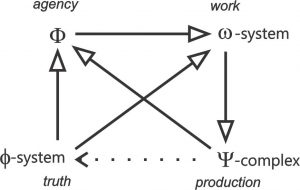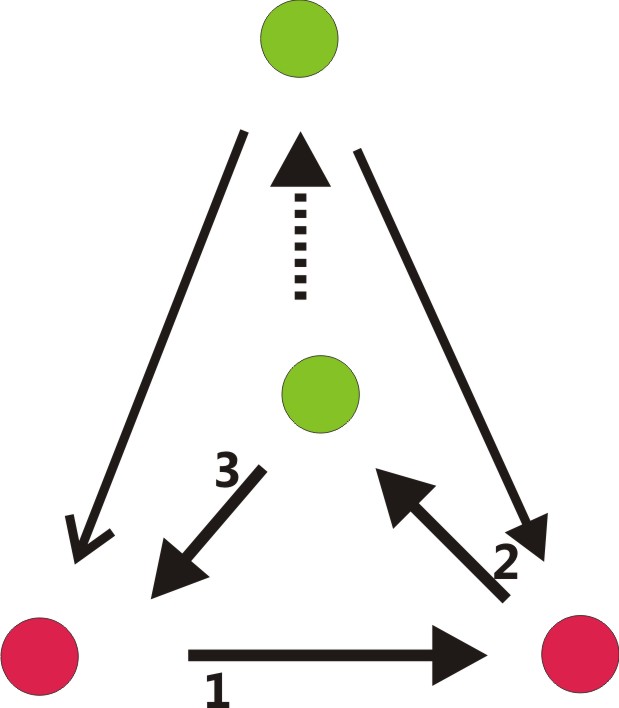In the following, I show the directedness of the edges of the topology of Freud’s basic schema as described by Lacan, and add the terms he used for the four ‘places’ in the topology of a discourse:

How did Lacan arrive at this? Here is what Lacan says in the Feb 3rd 1972 seminar on the topology underlying the structure of discourse:
The fact is that if its sides, namely, the little strokes that you see which join what are called in geometry the vertices… are vectorised… namely, if you give them direction, it is enough for you to posit as a principle that none of these vertices will be privileged in something… Because if that happened, there would be at least two which could not benefit from it. If then you posit that nowhere can there be a convergence of three vectors, and nowhere a divergence of three vectors from the same vertex, you will obtain necessarily then the arrangement: 2 vertices with 2-in/1-out, and 2 vertices with 2-out/1-in.
There are four possible ways of arranging four vertices to create different relationships between the directions of circulation on the surfaces of this quadripod:
These four possible arrangements reduce to one form through rotation, appearing as follows:
 There are then two possible ways of arranging this in the form of Lacan’s quadripod:
There are then two possible ways of arranging this in the form of Lacan’s quadripod:
 Both conserve the 1-2-3 cycle, but the left-hand one establishes the circular path of the “circle which is broken” around its outer edges, described by Lacan in his March 17th, 1971 Seminar XVIII:
Both conserve the 1-2-3 cycle, but the left-hand one establishes the circular path of the “circle which is broken” around its outer edges, described by Lacan in his March 17th, 1971 Seminar XVIII:
“It is in the measure that one makes these structures turn on the four lines of the circuit that follow one another in the tetrahedron, this is a condition, are fitted in the same direction, in this direction that turns around one, it does not matter which of the two others, of the three others, that the variation is established about what is involved in the structure of discourse, very precisely in so far as it remains at a certain level of construction which is the tetrahedric one, this tetrahedric one that we cannot be satisfied with once the agency of the letter is brought out. It is even because one cannot be satisfied with it, that to remain at its level, there is always one of the sides of what makes the circle which is broken.”
The importance of this “circle which is broken” appears in the May 16th 1962 Seminar IX as the importance of the hole in a surface, the ‘rim’ in the drive structure:
“If it is possible to show you a fundamental surface without edges, where the definition of the face is not necessary, (then) because the surface without edges is not suitable for resolving the problem of inside and outside, we ought to take into account the distinction between a surface without and a surface with: it has the closest possible relationship with what interests us, namely the hole which is to be made (to) enter positively as such into the theory of surfaces.
This is not a verbal artifice. In the combinatory theory of general topology, on every triangulatable surface – namely one composable of little triangular pieces that you could stick onto one another – (the) torus or cross-cap can be reduced by means of the fundamental polygon to a composition of the sphere, to which there would be added more or less toric elements, cross-cap elements and the indispensible elements of pure holes represented by this vector looping back on itself.
The structure of this quadripod becomes crucial when considering the perverse form that Lacan introduces in Lacan-in-Italy, Milan. This is described by him in terms of the relation between the discourses of the Master and of Capitalism, in which the positions of the S1 and $ are switched in the quadripod’s left-hand red and green positions:
“I am not saying to you that capitalist discourse is rotten, on the contrary… It is the cleverest discourse that we have made, but it is no less headed for a blowout. This is because it is untenable… a little inversion between the S1 and $… that consumes itself so that it is consumed.”
Thus the structure of discourse can be seen to be founded on a topologising of Freud’s Project. And through the elaboration of this topology with the support of the Project, it becomes possible to distinguish the four discourses from their perverse forms, and to suggest a different way of ‘reading’ what an organisation is.
Again using the Maturana language, I am not trying to formulate the organisation in terms of its viability – this would be to confuse the physical substrate of the organisation with the processes of organisation themselves. It is organisation of the identifications supported by the organisation I am interested in, so that I am examining a kind of co-ontological drift by a multiplicity of organisations of ‘s which are somehow organised in relation to each other through the effects of their respective valencies to , and insofar as the -systems and -complexes are coordinated in the ways in which they organise the pleasure-reality dialectic under the effects of a valent can be thought of as a system as a whole.
The form this takes is as an Economy of Discourses [1], in which I formulate the identifications supported by the organisation in terms of the way the economy ‘locks’ together around an underlying topology which, at a different order of complexity, can be described in terms of the structuring effects of the ‘quadripod’.
Footnotes
[1] An early attempt to formulate this concept is in “The economy of discourses: a third order cybernetics” with J.V. Kenny. Human Systems Management Volume 9 Number 4 1990 pp 205-224.

